Project to reintroduce critically endangered marsupial in South Australia, involving lures with nut spread, has surpassed expectations
Graham Readfearn
@readfearn
GUARDIAN AUSTRALIA
Thu 18 May 2023
The Australian bush was once full of rabbit-size marsupials darting and jumping around “like mini-kangaroos on steroids”, says ecologist Derek Sandow.
But since European invasion, the arrival of cats and foxes and the disappearance of habitat has left the brush-tailed bettong hanging on in only a handful of spots on the vast continent and on island refuges.
“They would have been one of the most common small mammals across the southern half of Australia,” says Sandow. “But they’ve gone missing from almost the entire mainland.”
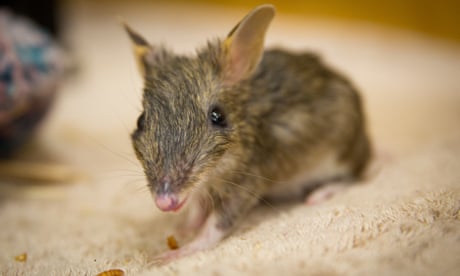
Conservation efforts celebrated as 26 Australian species no longer need threatened listing
However, a project to reintroduce the critically endangered bettongs to Yorke Peninsula in South Australia – a boot-shaped chunk of mainland that probably hasn’t seen them for more than a century – is having a startling and unexpected success.
Since August 2021, some 120 bettongs have been tagged and introduced to the Dhilba Guuranda-Innes national park on the peninsula’s south-west tip. Chloe Frick, a PhD candidate at the University of Adelaide, guesses there may now be up to 200 bettongs on the peninsula.
“It’s surpassing everyone’s expectations,” she says. “And it’s down to a lot of people working really hard. It is unifying and inspiring to see these animals succeeding and digging around in the landscape.”
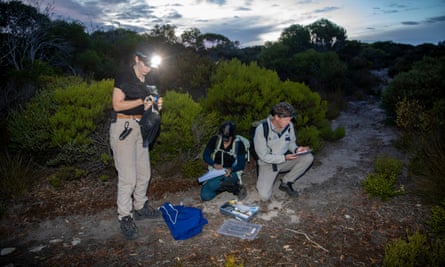
The Australian bush was once full of rabbit-size marsupials darting and jumping around “like mini-kangaroos on steroids”, says ecologist Derek Sandow.
But since European invasion, the arrival of cats and foxes and the disappearance of habitat has left the brush-tailed bettong hanging on in only a handful of spots on the vast continent and on island refuges.
“They would have been one of the most common small mammals across the southern half of Australia,” says Sandow. “But they’ve gone missing from almost the entire mainland.”

Conservation efforts celebrated as 26 Australian species no longer need threatened listing
However, a project to reintroduce the critically endangered bettongs to Yorke Peninsula in South Australia – a boot-shaped chunk of mainland that probably hasn’t seen them for more than a century – is having a startling and unexpected success.
Since August 2021, some 120 bettongs have been tagged and introduced to the Dhilba Guuranda-Innes national park on the peninsula’s south-west tip. Chloe Frick, a PhD candidate at the University of Adelaide, guesses there may now be up to 200 bettongs on the peninsula.
“It’s surpassing everyone’s expectations,” she says. “And it’s down to a lot of people working really hard. It is unifying and inspiring to see these animals succeeding and digging around in the landscape.”

Members of the Marna Banggara project boosting brush-tailed bettong numbers at work in South Australia’s Yorke Peninsula.
Photograph: Quentin Jones/WWF-Aus/think Mammoth
‘They’re suckers for peanut butter’
Bettongs make their nests under dense vegetation and are good at hiding from native predators such as wedge-tailed eagles, says Sandow, from South Australia’s Northern and Yorke Landscape Board.
“But those introduced predators – the cats and foxes – have really good smell and they can find them,” Sandow says.
In the 1970s, as bettongs were disappearing, an “insurance population” was started on the tiny and feral-free Wedge Island to the peninsula’s west. That starter group of 11 bettongs has since grown to a population of about 2,500.
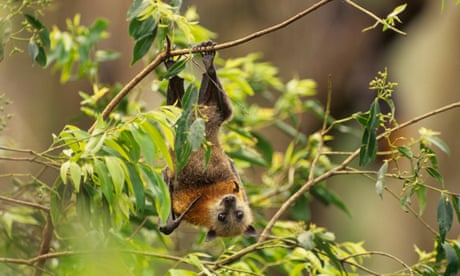
System to protect Australia’s threatened species from development ‘more or less worthless’, study finds
In August 2021, 40 bettongs were moved from the island to the national park. In 2022, another 44 Wedge Island bettongs joined them, along with 36 more flown 2,000 kilometres from the Upper Warren region of Western Australia, about 300km south of Perth and the species’ last remaining stronghold on the mainland.
Later this year, another 120 will arrive from WA in the project’s final leg of the reintroduction phase.
The work is part of Marna Banggara, a project to restore lost native wildlife to the area backed by the landscape board and state and federal government support together with WWF-Australia, the Foundation for National Parks and Wildlife and the Narungga Nation Aboriginal Corporation, with backing of the Narungga people and a host of other groups.

A bettong is examined by Chloe Frick in the Marna Banggara project.
Photograph: Quentin Jones/WWF-Aus/think Mammoth
Sandow was among a team that went to the park in March to catch and check on the bettong population using cage traps with baits of peanut butter, oats and vanilla essence.
“They’re suckers for the peanut butter,” says Sandow.
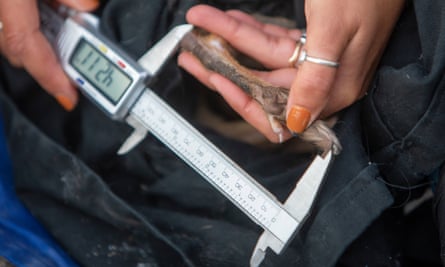
Sandow was among a team that went to the park in March to catch and check on the bettong population using cage traps with baits of peanut butter, oats and vanilla essence.
“They’re suckers for the peanut butter,” says Sandow.

Chloe Frick measuring a bettong’s leg.
Photograph: Quentin Jones/WWF-Aus/think Mammoth
Of the 85 bettongs caught, almost half did not have any tags or microchips of the original groups, meaning they were born on the peninsula.
“They are having so many babies,” says Frick. “If I could bottle that feeling of having an animal in a bag and then opening it up to see two fresh bettong ears, it is phenomenal. Every time I see a new one I’m blown away. To catch 85 when we only reintroduced 120 is fantastic.”
Before releasing them back, Frick gathers an array of data, from health and size checks to DNA samples and swabs of their micro-biome.
One juvenile male – known as a “young at foot” – was a second generation on the peninsula, with his mum also born there. Among the 45 mature females caught, 42 were carrying young in their pouch.
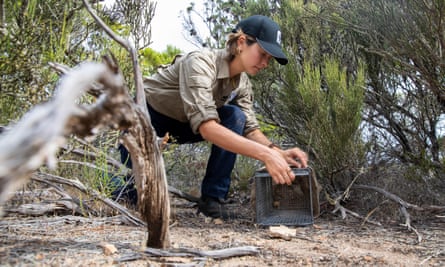
Of the 85 bettongs caught, almost half did not have any tags or microchips of the original groups, meaning they were born on the peninsula.
“They are having so many babies,” says Frick. “If I could bottle that feeling of having an animal in a bag and then opening it up to see two fresh bettong ears, it is phenomenal. Every time I see a new one I’m blown away. To catch 85 when we only reintroduced 120 is fantastic.”
Before releasing them back, Frick gathers an array of data, from health and size checks to DNA samples and swabs of their micro-biome.
One juvenile male – known as a “young at foot” – was a second generation on the peninsula, with his mum also born there. Among the 45 mature females caught, 42 were carrying young in their pouch.

Bettong traps are set on the Yorke Peninsula to enable checks of their health.
Photograph: Quentin Jones/WWF-Aus/think Mammoth
A fence-free safe haven
On the perimeter of the peninsula, a fence cuts off a main route for feral cats and foxes to invade. Numbers of ferals are kept down with poison, shooting and trapping.
Rob Brewster, WWF-Australia’s Rewilding Project manager, says the monitoring showed the species could be successfully reintroduced if there was suitable habitat and feral controls.
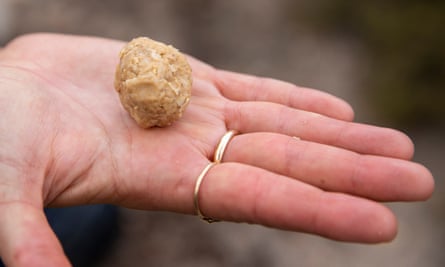
Bettongs are ‘suckers for the peanut butter’, says ecologist Derek Sandow.
Photograph: Quentin Jones/WWF-Aus/think Mammoth
“If this population can be sustained over time, it would be the first successful reintroduction of this species beyond islands and fenced safe havens,” Brewster says.
The listing of more Australian bird species as ‘threatened’ is alarming – but also cause for hope
Sean Dooley
There are hopes other locally extinct species like the southern brown bandicoot, red-tailed phascogale and western quoll could follow the bettongs.
Reintroducing the bettongs should see a cascade of positive effects. The bettongs – known as woylies in WA and yalgi in local Narungga language – are prolific diggers, with one single animal moving between two and six tonnes of soil a year.
By digging, bettongs improve the soil, spread seeds and create micro-climates and water pools for bugs and plants to grow.
“They’re an eco-system engineer,” Sandow says. “Their preferred food is fungi but they’ll eat tubers and vegetation and insects in the soil. But they are really big diggers. We hope that’s going to improve the bushland.”
Right now, the new bettongs are sticking to the native vegetation but radio tags show they’ve moved up to 10km away from release sites. The data also shows the animals from Wedge Island and WA are mixing and breeding, strengthening the genetic diversity among the population.
“They’re finding food, they’re finding shelter and they’re finding mates,” says Sandow. Handlers have to be careful, though, because while they’re an “adorable” animal to look at, they have a less-than-adorable strategy if they feel too threatened.
As they sprint and zig-zag away, some bettongs will eject their young from their pouch in an attempt to distract their pursuer.
“In the wild that’s a great strategy, but it means we have to be really wary,” says Sandow.
Photograph: Quentin Jones/WWF-Aus/think Mammoth
“If this population can be sustained over time, it would be the first successful reintroduction of this species beyond islands and fenced safe havens,” Brewster says.
The listing of more Australian bird species as ‘threatened’ is alarming – but also cause for hope
Sean Dooley
There are hopes other locally extinct species like the southern brown bandicoot, red-tailed phascogale and western quoll could follow the bettongs.
Reintroducing the bettongs should see a cascade of positive effects. The bettongs – known as woylies in WA and yalgi in local Narungga language – are prolific diggers, with one single animal moving between two and six tonnes of soil a year.
By digging, bettongs improve the soil, spread seeds and create micro-climates and water pools for bugs and plants to grow.
“They’re an eco-system engineer,” Sandow says. “Their preferred food is fungi but they’ll eat tubers and vegetation and insects in the soil. But they are really big diggers. We hope that’s going to improve the bushland.”
Right now, the new bettongs are sticking to the native vegetation but radio tags show they’ve moved up to 10km away from release sites. The data also shows the animals from Wedge Island and WA are mixing and breeding, strengthening the genetic diversity among the population.
“They’re finding food, they’re finding shelter and they’re finding mates,” says Sandow. Handlers have to be careful, though, because while they’re an “adorable” animal to look at, they have a less-than-adorable strategy if they feel too threatened.
As they sprint and zig-zag away, some bettongs will eject their young from their pouch in an attempt to distract their pursuer.
“In the wild that’s a great strategy, but it means we have to be really wary,” says Sandow.
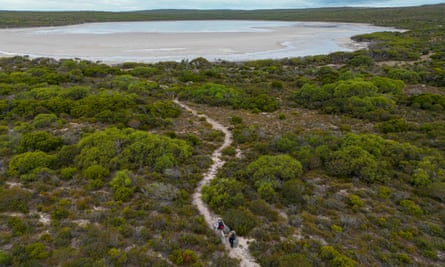
Marna Banggara project members on a track in Dhilba Guuranda-Innes national park, where brush-tailed bettongs have been re-introduced after local extinction.
Photograph: Quentin Jones/WWF-Aus/think Mammoth
Frick says bettongs – which can have three young a year – can also hold a fertilised egg “in their back pocket” so if they lose a baby from their pouch, they trigger a hormone that releases the egg so they can start growing a new baby within a few days.
Frick has begun to spot personality traits in some of the bettongs, including one – nicknamed Friar Tuck for his bald spot. Friar Tuck has been caught multiple times in the same day – “I think to get a free feed,” says Frick.
Bachelorette Bettong has avoided male attention and is camped near a park hut. Others have the names of Australian singers, including “Jimmy Barnes”, who Frick says is skilled at evading capture.
“Once [Jimmy] was stood in the middle of the road just a few metres in front of me,” remembers Frick.
“He turned to me and I swear he winked before he ran off.”
Photograph: Quentin Jones/WWF-Aus/think Mammoth
Frick says bettongs – which can have three young a year – can also hold a fertilised egg “in their back pocket” so if they lose a baby from their pouch, they trigger a hormone that releases the egg so they can start growing a new baby within a few days.
Frick has begun to spot personality traits in some of the bettongs, including one – nicknamed Friar Tuck for his bald spot. Friar Tuck has been caught multiple times in the same day – “I think to get a free feed,” says Frick.
Bachelorette Bettong has avoided male attention and is camped near a park hut. Others have the names of Australian singers, including “Jimmy Barnes”, who Frick says is skilled at evading capture.
“Once [Jimmy] was stood in the middle of the road just a few metres in front of me,” remembers Frick.
“He turned to me and I swear he winked before he ran off.”
No comments:
Post a Comment